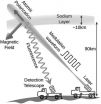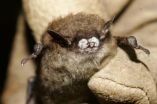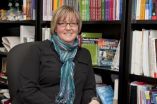(Press-News.org) Mapping the Earth's magnetic field – to find oil, track storms or probe the planet's interior – typically requires expensive satellites.
University of California, Berkeley, physicists have now come up with a much cheaper way to measure the Earth's magnetic field using only a ground-based laser.
The method involves exciting sodium atoms in a layer 90 kilometers above the surface and measuring the light they give off.
"Normally, the laser makes the sodium atom fluoresce," said Dmitry Budker, UC Berkeley professor of physics. "But if you modulate the laser light, when the modulation frequency matches the spin precession of the sodium atoms, the brightness of the spot changes."
Because the local magnetic field determines the frequency at which the atoms precess, this allows someone with a ground-based laser to map the magnetic field anywhere on Earth.
Budker and three current and former members of his laboratory, as well as colleagues with the European Southern Observatory (ESO), lay out their technique in a paper appearing online this week in the journal Proceedings of the National Academy of Sciences.
Various satellites, ranging from the Geostationary Operational Environmental Satellites, or GOES, to an upcoming European mission called SWARM, carry instruments to measure the Earth's magnetic field, providing data to companies searching for oil or minerals, climatologists tracking currents in the atmosphere and oceans, geophysicists studying the planet's interior and scientists tracking space weather.
Ground-based measurements, however, can avoid several problems associated with satellites, Budker said. Because these spacecraft are moving at high speed, it's not always possible to tell whether a fluctuation in the magnetic field strength is real or a result of the spacecraft having moved to a new location. Also, metal and electronic instruments aboard the craft can affect magnetic field measurements.
"A ground-based remote sensing system allows you to measure when and where you want and avoids problems of spatial and temporal dependence caused by satellite movement," he said. "Initially, this is going to be competitive with the best satellite measurements, but it could be improved drastically."
Laser guide stars
The idea was sparked by a discussion Budker had with a colleague about of the lasers used by many modern telescopes to remove the twinkle from stars caused by atmospheric disturbance. That technique, called laser guide star adaptive optics, employs lasers to excite sodium atoms deposited in the upper atmosphere by meteorites. Once excited, the atoms fluoresce, emitting light that mimics a real star. Telescopes with such a laser guide star, including the Very Large Telescope in Chile and the Keck telescopes in Hawaii, adjust their "rubber mirrors" to cancel the laser guide star's jiggle, and thus remove the jiggle for all nearby stars.
It is well known that these sodium atoms are affected by the Earth's magnetic field. Budker, who specializes in extremely precise magnetic-field measurements, realized that you could easily determine the local magnetic field by exciting the atoms with a pulsed or modulated laser of the type used in guide stars. The method is based on the fact that the electron spin of each sodium atom precesses like a top in the presence of a magnetic field. Hitting the atom with light pulses at just the right frequency will cause the electrons to flip, affecting the way the atoms interact with light.
"It suddenly struck me that what we do in my lab with atomic magnetometers we can do with atoms freely floating in the sky," he said.
Budker's former post-doctoral fellow James Higbie now an assistant professor of physics and astronomy at Bucknell University – conducted laboratory measurements and computer simulations confirming that the effects of a modulated laser could be detected from the ground by a small telescope. He was assisted by Simon M. Rochester, who received his Ph.D. in physics from UC Berkeley last year, and current post-doctoral fellow Brian Patton.
Portable laser magnetometers
In practice, a 20- to 50-watt laser small enough to load on a truck or boat tuned to the orange sodium line (589 nanometer wavelength) would shine polarized light into the 10 kilometer-thick sodium layer in the mesosphere, which is about 90 kilometers overhead. The frequency with which the laser light is modulated or pulsed would be shifted slightly around this wavelength to stimulate a spin flip.
The decrease or increase in brightness when the modulation is tuned to a "sweet spot" determined by the magnitude of the magnetic field could be as much as 10 percent of the typical fluorescence, Budker said. The spot itself would be too faint to see with the naked eye, but the brightness change could easily be measured by a small telescope.
"This is such a simple idea, I thought somebody must have thought of it before," Budker said.
He was right. William Happer, a physicist who pioneered spin-polarized spectroscopy and the sodium laser guide stars, had thought of the idea, but had never published it.
"I was very, very happy to hear that, because I felt there may be a flaw in the idea, or that it had already been published," Budker said.
While Budker's lab continues its studies of how spin-polarized sodium atoms emit and absorb light, Budker's co-authors Ronald Holzlöhner and Domenico Bonaccini Calia of the ESO in Garching, Germany, are building a 20-watt modulated laser for the Very Large Array in Chile that can be used to test the theory.
INFORMATION:
The work was supported by NGA NURI, the University Research Initiatives program of the National Geospatial-Intelligence Agency, which is part of the Department of Defense.
Ground-based lasers vie with satellites to map Earth's magnetic field
Physicists propose beaming laser at atmospheric sodium to measure global magnetic field
2011-02-15
ELSE PRESS RELEASES FROM THIS DATE:
The UK is a nation of happy couples
2011-02-15
Researchers at the Institute for Social and Economic Research asked both individuals in the couple to rate their happiness on a seven point scale; from the lowest score of 'extremely unhappy' to the middle point of 'happy', the highest point being 'perfect'. The self-reported happiness rating revealed that 90 percent of married women and 88 percent of cohabiting women are happy in their relationships. Ninety-three percent of married men and 92 percent of cohabiting men said they were happy in their relationship.
The findings indicate the happiest couples are those in ...
British scientists develop control system to allow spacecraft to think for themselves
2011-02-15
The world's first control system that will allow engineers to programme satellites and spacecraft to think for themselves has been developed by scientists from the University of Southampton.
Professor Sandor Veres and his team of engineers have developed an artificially intelligent control system called 'sysbrain'.
Using natural language programming (NLP), the software agents can read documents written in English, rather than needing specially programmed code to be uploaded, to obtain new instructions or new information. This gives the vehicles advanced guidance, navigation ...
Estrogen reduces aggression in breast cancer
2011-02-15
A team of researchers at CIC bioGUNE has revealed that oestrogen can reduce the risk of breast cancer. Their work shows that oestrogen is capable of reducing the number of breast cancer stem cells, which may explain the lower aggression of the tumour and, as a consequence, the possibility of a better prognosis. The project was published in Breast Cancer Research and Treatment and the team will present the results under the auspices of the International Conference on Breast Cancer to be held in Madrid. The research combined the use of human samples and laboratory cell lines.
The ...
Moderate-to-heavy alcohol intake may increase risk of atrial fibrillation
2011-02-15
Atrial Fibrillation (AF) is the most common cardiac arrhythmia (abnormal heart rhythm). Its name comes from the fibrillating (i.e., quivering) of the heart muscles of the atria, instead of a coordinated contraction. The result is an irregular heartbeat, which may occur in episodes lasting from minutes to weeks, or it could occur all the time for years. Atrial fibrillation alone is not in itself generally life-threatening, but it may result in palpitations, fainting, chest pain, or congestive heart failure.
There is no doubt that heavy alcohol intake and binge drinking ...
Total cooperation among people is not viable
2011-02-15
The objective of this research is to understand how cooperation works in nature in general, and among humans in particular. "From the evolutionary point of view it is very difficult to understand why we would help others when what interests us is helping ourselves," explained the authors of this study, which was recently published in the journal PLoS ONE. One of the most striking conclusions drawn is that there are different types of people: those who always try to help their neighbors (around 5 percent), those who never do so (35 percent), and others who cooperate depending ...
Hand movements in children with ADHD hold clues to understanding and predicting symptom severity
2011-02-15
(Baltimore, MD) – Two research studies published today in Neurology®, the medical journal of the American Academy of Neurology, found markers for measuring the ability of children with Attention Deficit Hyperactivity Disorder (ADHD) to control impulsive movements, which may reveal insights into the neurobiology of ADHD, inform prognosis and guide treatments.
In one of two studies conducted by researchers at the Kennedy Krieger Institute in Baltimore, MD and the Cincinnati Children's Hospital Medical Center, children with ADHD performed a finger-tapping task. Any unintentional ...
More deep-sea vents discovered
2011-02-15
Scientists aboard the Royal Research Ship James Cook have discovered a new set of deep-sea volcanic vents in the chilly waters of the Southern Ocean. The discovery is the fourth made by the research team in three years, which suggests that deep-sea vents may be more common in our oceans than previously thought.
Using an underwater camera system, the researchers saw slender mineral spires three metres tall, with shimmering hot water gushing from their peaks, and gossamer-like white mats of bacteria coating their sides. The vents are at a depth of 520 metres in a newly-discovered ...
Culling can't control deadly bat disease
2011-02-15
Culling will not stop the spread of a deadly fungus that is threatening to wipe out hibernating bats in North America, according to a new mathematical model.
White-nose syndrome, which is estimated to have killed over a million bats in a three year period, is probably caused by a newly discovered cold-adapted fungus, Geomyces destructans. The new model examines how WNS is passed from bat to bat and concludes that culling would not work because of the complexity of bat life history and because the fungal pathogen occurs in the caves and mines where the bats live.
"Because ...
NIH study finds 2 pesticides associated with Parkinson's disease
2011-02-15
New research shows a link between use of two pesticides, rotenone and paraquat, and Parkinson's disease. People who used either pesticide developed Parkinson's disease approximately 2.5 times more often than non-users.
The study was a collaborative effort conducted by researchers at the National Institute of Environmental Health Sciences (NIEHS), which is part of the National Institutes of Health, and the Parkinson's Institute and Clinical Center in Sunnyvale, Calif.
"Rotenone directly inhibits the function of the mitochondria, the structure responsible for making ...
Playtime helps bind generations
2011-02-15
This release is available in French.
Montreal, February 14, 2010 – A new study has confirmed an old adage: A family that plays together stays together. Researchers from Concordia University and Wilfrid Laurier University examined the ways grandparents can maintain close ties with their adult grandchildren. True to the old maxim, recreation emerged as the glue sealing intergenerational bonds.
"Leisure is vital in the formation of bonds that last from generation to generation," says lead author Shannon Hebblethwaite, a professor in Concordia University's Department ...
LAST 30 PRESS RELEASES:
Quantum simulator sheds light on how nature moves energy in systems like photosynthesis and solar conversion
Can a hashtag help prevent atrocities? Study shows social media can be a powerful tool
The American Ornithological Society (AOS) announces the winner of the 2025 Wesley Lanyon Award
Woolly rhino genome recovered from Ice Age wolf stomach
An earthquake on a chip: New tech could make smartphones smaller, faster
New research shows how AI tools are expanding individual capabilities while contracting scientific attention
A nanomaterial flex — MXene electrodes help OLED display technology shine, while bending and stretching
Global research team uncovers mechanism by which metabolites guide cellular decisions
Work hours, stress, and burnout among resident physicians
Quality of life of parents of premature infants
Should younger and older people receive different treatments for the same infection?
Scientists discover how fast the world’s deltas are sinking
Scientists demonstrate first-time use of AI for genetic circuit design
Copenhagen researchers make the front page of Nature: Solving the mystery of the universe's ‘little red dots’
Seoul National University-Drexel University team achieves world's highest efficiency fully stretchable OLEDs with 17% external quantum efficiency
Hydrogel cilia set new standard in microrobotics
Application of orthogonal CNOP-I in a convection-allowing ensemble prediction system based on CMA-MESO for improving extreme precipitation skill
Study suggests bamboo has ‘superfood’ potential
Hidden heart-care gaps among Asian American patients
Blood test predicts which patients with lung cancer will benefit from newly approved immunotherapy drug
SwRI’s Dr. Michael Davis named SPIE Fellow
Exposure to “forever chemicals” linked to higher risk of gestational diabetes, major review finds
Insilico Medicine integrates Nach01 Foundation Model with Microsoft Discovery to enable AI-native, enterprise-ready drug discovery workflows
New study reveals precursors for forecasting summer clustered extreme precipitation events in Northeast China
A bacterial toxin can counteract colorectal cancer growth
Frozen hydrogen cyanide ‘cobwebs’ offer clues to origin of life
Physics of foam strangely resembles AI training
Bis-pseudoindoxyls: a new class of single benzene-based fluorophores for bioimaging applications
Blocking a cancer-related pathway helps reduce spine deformities due to genetic disorder, finds new study
New study explores therapeutic potential of CRISPRCas3 genome-editing system
[Press-News.org] Ground-based lasers vie with satellites to map Earth's magnetic fieldPhysicists propose beaming laser at atmospheric sodium to measure global magnetic field




